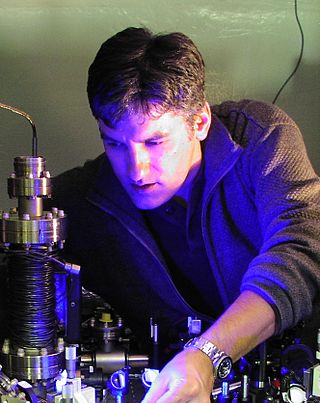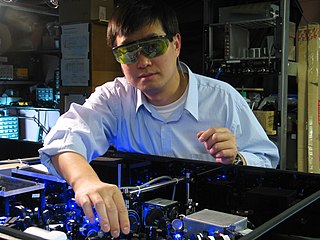
In condensed matter physics, a Bose–Einstein condensate (BEC) is a state of matter that is typically formed when a gas of bosons at very low densities is cooled to temperatures very close to absolute zero. Under such conditions, a large fraction of bosons occupy the lowest quantum state, at which point microscopic quantum mechanical phenomena, particularly wavefunction interference, become apparent macroscopically. A BEC is formed by cooling a gas of extremely low density to ultra-low temperatures.

Carl Edwin Wieman is an American physicist and educationist at Stanford University, and currently the A.D White Professor at Large at Cornell University. In 1995, while at the University of Colorado Boulder, he and Eric Allin Cornell produced the first true Bose–Einstein condensate (BEC) and, in 2001, they and Wolfgang Ketterle were awarded the Nobel Prize in Physics. Wieman currently holds a joint appointment as Professor of Physics and Professor in the Stanford Graduate School of Education, as well as the DRC Professor in the Stanford University School of Engineering. In 2020, Wieman was awarded the Yidan Prize in Education Research for "his contribution in developing new techniques and tools in STEM education." citation.

Eric Allin Cornell is an American physicist who, along with Carl E. Wieman, was able to synthesize the first Bose–Einstein condensate in 1995. For their efforts, Cornell, Wieman, and Wolfgang Ketterle shared the Nobel Prize in Physics in 2001.

A fermionic condensate or Fermi–Dirac condensate is a superfluid phase formed by fermionic particles at low temperatures. It is closely related to the Bose–Einstein condensate, a superfluid phase formed by bosonic atoms under similar conditions. The earliest recognized fermionic condensate described the state of electrons in a superconductor; the physics of other examples including recent work with fermionic atoms is analogous. The first atomic fermionic condensate was created by a team led by Deborah S. Jin using potassium-40 atoms at the University of Colorado Boulder in 2003.

Deborah Shiu-lan Jin was an American physicist and fellow with the National Institute of Standards and Technology (NIST); Professor Adjunct, Department of Physics at the University of Colorado; and a fellow of the JILA, a NIST joint laboratory with the University of Colorado.

Rudolf Grimm is an experimental physicist from Austria. His work centres on ultracold atoms and quantum gases. He was the first scientist worldwide who, with his team, succeeded in realizing a Bose–Einstein condensation of molecules.

John Lewis "Jan" Hall is an American physicist, and Nobel laureate in physics. He shared the 2005 Nobel Prize in Physics with Theodor W. Hänsch and Roy Glauber for his work in precision spectroscopy.
Brian Leeds DeMarco is a physicist and Professor of Physics at the University of Illinois at Urbana-Champaign. In 2005 he placed first in the quantum physics portion of the "Amazing Light" competition honoring Charles Townes, winner of the 1964 Nobel Prize in Physics. DeMarco is currently conducting experiments in quantum simulation.

Rainer Blatt is a German-Austrian experimental physicist. His research centres on the areas of quantum optics and quantum information. He and his team performed one of the first experiments to teleport atoms, the other was done at NIST in Boulder Colorado. The reports of both groups appeared back-to-back in Nature.
David Edward Pritchard is physics professor at the Massachusetts Institute of Technology (MIT). Professor Pritchard carried out pioneering experiments on the interaction of atoms with light that led to the creation of the field of atom optics. His demonstration of the diffraction of a beam of atoms by a grating made of light waves opened the way to studies of the diffraction, reflection, and focusing of matter waves, similar to those with light waves. He has applied atom optics to basic studies of quantum theory, to new methods for studying the properties of atoms, and to the creation of devices such as the atom interferometer and atom wave gyroscope.
The MIT School of Science is one of the five schools of the Massachusetts Institute of Technology, located in Cambridge, Massachusetts, United States. The School is composed of 6 academic departments who grant SB, SM, and PhD or ScD degrees; as well as a number of affiliated laboratories and centers. As of 2020, the Dean of Science is Professor Nergis Mavalvala. With approximately 275 faculty members, 1100 graduate students, 700 undergraduate majors, 500 postdocs, and 400 research staff, the School is the second largest at MIT. As of 2019, 12 faculty members and 14 alumni of the School have won Nobel Prizes.
Markus Greiner is a German physicist and Professor of Physics at Harvard University.
John David Reppy is a physicist and the John L. Wetherill Professor of Physics Emeritus at Cornell University. He studies the quantum properties of superfluids such as helium.

David Jeffrey Wineland is an American Nobel-laureate physicist at the National Institute of Standards and Technology (NIST) physics laboratory. His work has included advances in optics, specifically laser-cooling trapped ions and using ions for quantum-computing operations. He was awarded the 2012 Nobel Prize in Physics, jointly with Serge Haroche, for "ground-breaking experimental methods that enable measuring and manipulation of individual quantum systems".

Christopher Roy Monroe is an American physicist and engineer in the areas of atomic, molecular, and optical physics and quantum information science, especially quantum computing. He directs one of the leading research and development efforts in ion trap quantum computing. Monroe is the Gilhuly Family Presidential Distinguished Professor of Electrical and Computer Engineering and Physics at Duke University and is College Park Professor of Physics at the University of Maryland and Fellow of the Joint Quantum Institute and Joint Center for Quantum Computer Science. He is also co-founder and Chief Scientist at IonQ, Inc.

Ana Maria Rey is a Colombian theoretical physicist, professor at University of Colorado at Boulder, a JILA fellow, a fellow at National Institute of Standards and Technology and a fellow of the American Physical Society. Rey was the first Hispanic woman to win the Blavatnik Awards for Young Scientists in 2019.

Jun Ye is a Chinese-American physicist at JILA, National Institute of Standards and Technology, and the University of Colorado Boulder, working primarily in the field of atomic, molecular and optical physics.

Katharine Blodgett Gebbie was an American astrophysicist and civil servant. She was the founding Director of the Physical Measurement Laboratory of the National Institute of Standards and Technology (NIST), and of its two immediate predecessors, the Physics Laboratory and the Center for Atomic, Molecular and Optical Physics, both for which she was the only Director. During her 22 years of management of these institutions, four of its scientists were awarded the Nobel Prize in Physics. In 2015, the NIST Katharine Blodgett Gebbie Laboratory Building in Boulder, Colorado was named in her honor.
The Samuel Wesley Stratton Award has been annually presented by the National Institute of Standards and Technology since 1962 for "an unusually significant research contribution to science or engineering that merits the acclaim of the scientific world and supports NIST’s mission objectives". The award was named after first director of NIST, then NBS, Samuel Wesley Stratton. The award is considered NIST’s highest award for fundamental research.
The George Gamow Memorial Lectures are an annual series of lectures at the University of Colorado Boulder, named in honor of the physicist and science popularizer George Gamow, author of such popular science works as One Two Three... Infinity and the Mr Tompkins series.













